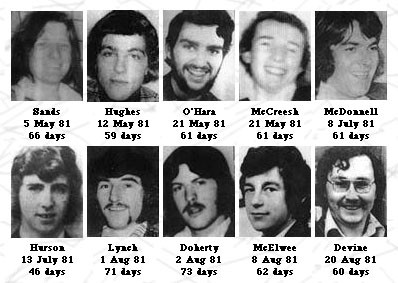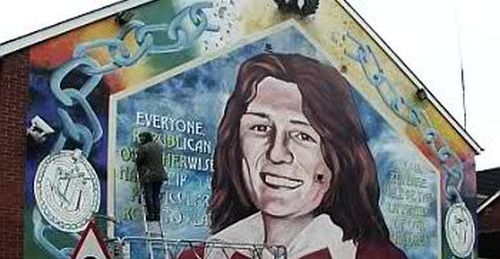
The hunger strikes of 1980/1981, in which ten men including Bobby Sands died, are the most famous use of that political weapon. Yet hunger striking has a long history in Irish political culture. It is said that the ancient Celts practiced a form of hunger strike called Troscadh or Cealachan, where someone who had been wronged by a man of wealth fasted on his doorstep. Some historians claim that this was a death fast, which usually achieved justice because of the shame one would incur from allowing someone to die on their doorstep. Others say it was a token act that was never carried out to the death - it was simply meant to publicly shame the offender. In any case, both forms of protest have been used quite regularly as a political weapon in modern Ireland.
The history of Irish resistance to British colonialism is full of heroes who died on hunger strike. Some of the best-known include Thomas Ashe, a veteran of the 1916 "Easter Rising", who died after he was force-fed by the British in Dublin's Mountjoy Jail. In 1920, three men including the mayor of Cork City Terence MacSwiney died on hunger strike in England's Brixton Prison. In October 1923 two men died when up to 8,000 IRA prisoners went on hunger strike to protest their imprisonment by the new "Irish Free State" (formed after the partition of Ireland in 1921). Three men died on hunger strike against the Irish government in the 1940s. After the IRA was reformed in the 1970s, hunger strikes became common once again. IRA man Michael Gaughan died after being force-fed in a British prison in 1974. And Frank Stagg died in a British jail after a 62-day hunger strike in 1976.
Unlike in Turkey, the Irish make no distinction between a "hunger strike" and a "death fast," although many hunger strikes have started without the intention of anyone dying. In 1972, IRA prisoners successfully won status as political prisoners after a hunger strike in which no one died. They were then moved to Long Kesh prison camp, where they lived in dormitory-style huts and self-organized their education (including guerrilla training), work (including cooperative handicrafts production), recreation, and attempts to escape and rejoin the conflict. The prisoners used their relative freedom to raise their collective and individual consciousness about their struggle against British occupation of Ireland. They read international revolutionaries like Che Guevara and Irish socialists such as James Connolly. This was, in turn, a foundation for rebuilding the IRA on a basis that inc luded a less hierarchical and more participative structure, with a higher emphasis on community politics as a part of armed struggle.
luded a less hierarchical and more participative structure, with a higher emphasis on community politics as a part of armed struggle.
As the IRA rebuilt their organization in prison the British government also changed strategy. The main pillar of the new strategy was a "conveyor belt" of security operations that included widespread arrests of young Catholic males, heavy interrogation including torture, and juryless courts in which a single judge pronounced guilt often on the sole basis of verbal or written statements under interrogation. At the end of the process was a new prison structure. All prisoners found guilty of offences committed after March 1976 were stripped of political status and committed to cellular confinement in the newly- built "H-Blocks" of Long Kesh prison. There were eight cellblocks built in the shape of an "H" (later copied on Robben Island in South Africa), with 25 cells on each wing and an administrative area on the crossbar of the "H".
Eventually, this new cellular prison structure -as in Turkey in 2000 after operation "return to life" and the violent transfer of prisoners to F-type prisons - would lead to an intense hunger strike with the deaths of ten men including Bobby Sands.
Here the similarity with the 2000-2006 Turkish hunger strike ends. Instead of embarking immediately on hunger strike, IRA prisoners went through five long years of intense struggle against cellular confinement. Their conditions of confinement were horrific: when an IRA prisoner refused to be criminalized by wearing a prison uniform he was thrown into a small cell without clothing, reading materials (only a bible and a few religious pamphlets), pens, paper, or any appliances such as a radio. The cell included only basic furniture - a bed, a desk, and a locker. The only personal items the prisoners were allowed were soap, toothpaste, a toothbrush, a hairbrush, and four small packets of tissues a month. Having no clothing, the prisoners wore their blankets around their shoulders and waists and, thus, became known as "blanketmen". The blanketmen were kept in bare lockup 24 hours a day, seven days a week for five years. They were allowed out of their cells only on Sunday to attend religious mass in the block cafeteria and to go on one monthly half-hour visit with family or friends.
In these bare conditions, an incredible thing happened. The prisoners began several years of collective resistance to the regime. Each act of protest was followed by horrible new punishments and deprivations by the authorities. The guards stopped letting the prisoners go to showers. They refused to take away prisoners' "slop buckets" even though they were overflowing with human waste. They took away all of their furniture except a foam mattress. All the men were allowed to receive from their families was a packet of tissues each month.
When the prisoners tried to slop their urine under their cell doors, the guards pushed it back in and they woke up each morning on foam mattresses soaked in urine. When prisoners threw their feces out the window, the guards threw it back into the cells. Eventually the men were reduced to lying naked in their cells, with their excrement smeared on the walls and their food waste heaped in the corner.
Surprisingly, each new punishment made the prisoners stronger. They went on monthly visits to their relatives and smuggled back small comforts including tobacco, ballpoint pen refills, cigarette papers (for writing on), educational materials (tiny writing on cigarette papers), and plastic wrap (to keep everything protected from bodily fluids when they were hidden inside the prisoner's body). By smuggling, the prisoners also maintained contact with the outside movement. Their smuggled accounts of prison conditions became the raw material for a public support campaign.
Most importantly, over five years the prisoners built a publicity campaign that ensured that everyone in Ireland knew what was happening in the H-Blocks, despite a ban on supporters of the IRA or its political party Sinn Fein appearing in the public media. They built a "propaganda factory" where each prisoner wrote several letters a day on cigarette papers, and then smuggled them out to be sent to influential people the world over. Bobby Sands smuggled a message to the movement outlining a massive publicity campaign to support the prisoners. He wrote:
The idea to reach people is to pass a simple message to them. Our simple message to everyone will be "Smash H-Block" . . . We want to get this message to everyone, we want to make it impossible for people to forget it, no matter who they are or where they are, they shall see it, hear it. Backing this will be material on H-Block to stir people's emotions and to arouse them and activate them.
Sands suggested that the movement would put up "millions of posters" and that the slogan "Smash H- Block" would be written and then re-written on every wall and bridge in Ireland and even in Britain, on highways and public buildings. People should see pictures of children in t-shirts or carrying signs that read "Don't Let My Daddy Die in H-Block."
And this is what happened. Despite the media blackout in Britain and in Ireland, the message of the IRA prisoners on protest was soon known by everyone. They saw it everywhere they went, even on the money that they spent in their local shops (people wrote "H-Block" on money before they spent it). And then the message spread through the huge Irish emigrant communities in North America, Britain, and Australia.
I spent six years researching a biography of Bobby Sands. When people ask me, "what is the most important thing you learned about Bobby Sands?" I tell them one simple thing. The most important thing about Bobby Sands is not how he died on hunger strike, it is how he lived. Through his energy, he built a movement and a community inside of the H-Blocks that the world could not ignore.
THEN, in that terrible time beginning in late 1980, Irish prisoners began to go on hunger strike to the death. A first hunger strike ended in failure in December 1980, when its leader told the prison authorities to feed a hunger striker who was dying. By the time Bobby Sands began a hunger strike in March 1981, the men who went on it knew that they would likely die.
There was no pressure on any prisoner to participate. Quite the opposite. The Commanding Officer of the IRA in the prison sent a letter to every man and woman who volunteered for the hunger strike, trying to talk them out of participating. The letter stated that if they began a hunger strike death was the likely outcome. They had to be sure of themselves because if they "backed down at the last minute," they would do irreparable damage to the other hunger strikers. The letter said that there was no shame in withdrawing their name and that the hunger strike was entirely voluntary. Each prisoner should be sure that if they started to hunger strike they would continue, if necessary until death.
Ten prisoners died on the hunger strike, led by Bobby Sands. They won a clear moral victory. The world's media overwhelmingly supported them. The New York Times said that Bobby Sands, who won election as a member of British parliament before he died, had "bested an implacable British prime minister." National parliaments honored the hunger strikers with resolutions and moments of silence. Political prisoners in Chiapas in Mexico, who would later form the Zapatista movement, went on hunger strike following the Irish example in the summer of 1981. Nelson Mandela and young ANC prisoners in South Africa did likewise. This all happened because of dozens of Irish prisoners went on hunger strike, including the ten men who died. But it also happened because of the five years of struggle and building that the blanketmen and their supporters on the outside had accomplished, in spite of a hostile media and a ban on their representatives appearing in the public media.
After the hunger strike finally ended, the Irish prisoners regained political status. They soon had control over prison spaces in the H-blocks, which they ran again on collective lines. After they left prison, many prisoners took their politics into their communities, creating and participating in alternative Irish schools, housing projects, cooperatives, development organizations, arts groups, and the like.
And the Irish hunger strikers were remembered around the world. The street in front of the British embassy in Tehran is still called "Bobby Sands Street." Turkish prisoners conducted a horrific death fast between 2000 and 2006. They tell me that the code word they used for their action was "Bobby Sands." In the US state of Ohio in 2011, three death-sentenced prisoners had been kept in total isolation for nearly twenty years. They read about Bobby Sands and the Irish hunger strikers and were encouraged to organize their own hunger strike for the right to have contact visits instead of visiting their loved ones behind security glass. They won their struggle after 12 days. In California, later in the same year, 6,000 prisoners went on hunger strike. Again, they read about Bobby Sands and his comrades in Ireland and they became convinced that they, too, could do something about the horrific conditions of isolation in which they had been held, some for more than twenty years. In both Ohio and California, the prisoners took an important message from Bobby Sands and his Irish comrades: they mobilized a public campaign outside of prison that would support them emotionally and put pressure on the government to listen to their just demands.
Hunger striking is a horrific thing. It is a slow and painful way to die. Those who choose to do it, do so because their conditions have become so intolerable that continuing to live in them is worse than going through this horrible ideal. It is their last step of resistance. They are moved by feelings of solidarity and love for their fellow prisoners, to a degree that the rest of us cannot imagine.
Fidel Castro perhaps came closest to expressing the enormity of the act of hunger striking, when he praised Bobby Sands and his comrades:
Tyrants shake in the presence of men who have such strength as to die for their ideals through sixty days of hunger strike! Next to this example, what were the three days of Christ on Cavalry as a symbol of human sacrifice down the centuries?
And now hunger strike has once again returned to Turkey. The experiences of Ireland and North America show that there is only one thing that can help them win their struggle: public knowledge and public support. Without it, they are on their own.
* Denis O'Hearn is Professor of Sociology at State University of New York - Binghamton and author of the definitive biography of Bobby Sands, Nothing but an Unfinished Song: Bobby Sands, the Irish Hunger Striker Who Ignited a Generation.





